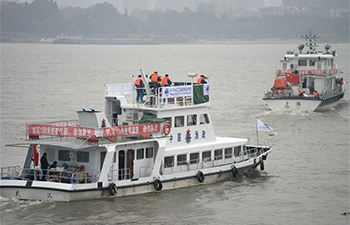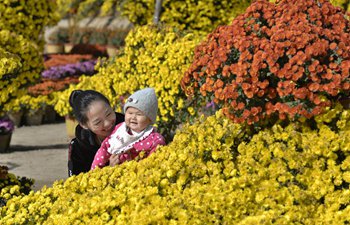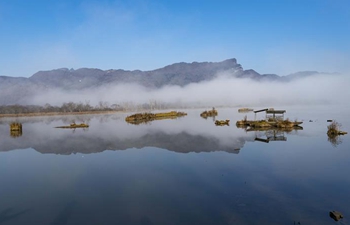KATHMANDU, Nov. 10 (Xinhua) -- Nepal's Ministry of Agriculture Development (MoAD) is considering its options after sudden downpours in mid-August had affected its rice paddy transplantation.
Usually, the transplantation of paddies, which is the largest contributor to the country's agricultural sector, should be concluded by mid-August in Nepal.
However, the Himalayan nation witnessed unexpected downpours of incessant rain particularly on the south-eastern plains starting from August 11 and ending on August 15, which led to 150 people losing their lives and damage to more than 43,000 houses.
The floods caused the loss of 7.22 billion Nepali rupees (69 million U.S. dollars) in the agriculture sector, affecting paddies, maize, bananas, spices and fish farming as per revised estimates, according to the MoAD.
"It is the largest ever damage to the crops from the flooding," Maniratna Aryal, an information officer at MoAD, told Xinhua.
The floods had affected as much as 80 percent of the southern agricultural belt, according to government statistics.
This has once again highlighted Nepal's vulnerability to climate change, related hazards and the country's unpreparedness to tackle such situations, according to Nepali government officials and experts.
This biggest climate-related risks are not to human lives but to the agriculture sector, on which most of the people are dependent, they said.
According to officials, Nepal's agriculture sector has been particularly vulnerable because of the fact that the Himalayan country does not have the technology or the experience of forecasting weather for more than 48 hours in advance.
"Had we known about the adverse weather condition lasting for a longer period, we might have been more prepared for the impending floods in August," said Aryal, who is also a senior agricultural economist.
With the agriculture ministry failing to provide longer forecasts about future weather conditions to the farmers, the agriculture sector has been vulnerable to changing patterns of weather.
More than 70 percent of Nepal's cultivated land relies on rain and it has been affected by the erratic patterns of rainfall, drought, flash floods and landslides over the years, posing a great risk to Nepal's food security.
"At a time when the cultivated land for staple food has been decreasing due to large number of Nepali migrating out of the areas and urbanization, disasters caused by atypical weather conditions such as floods and droughts could seriously hit the food security situation of the country," said Hari Dahal, an agricultural expert and former government secretary.
According to the Central Bureau of Statistics (CBS) of Nepal, a government body for conducting studies on various areas of the national economy, "over the last decade, around 30,845 hectares of land owned by almost 5 percent of households became uncultivable due to the climate-related hazards."
Experts said as the climate change is a global phenomenon, Nepal has to adopt farming practices adaptable to climate change to avoid risking a further loss of food security.
Yamuna Ghale, senior program officer of the agriculture and food security at the Kathmandu-based Swiss embassy, told Xinhua that climate change has not only adversely affected the agriculture sector, but has also opened up new opportunities that must be tapped.
"For example, crops meant for Nepal's southern tropical regions might be cultivated in hilly regions as a result of climate change. This is also an opportunity because people from hilly regions might cultivate them and take to the taste of such foods," she said.
Experts, however, have emphasized the need to develop technologies and practices that are adaptable to climate change and benefit from the emerging opportunities.
According to the agriculture ministry of Nepal, it has introduced a number of new varieties of paddy seeds which are tolerant to droughts, can survive in floods and inundation. It's also promoting some farming practices that require no paddy transplantation process.
"Our biggest focus is on developing paddy seeds that are flexible to climate change because rice is the main food of Nepal," said Aryal.

















